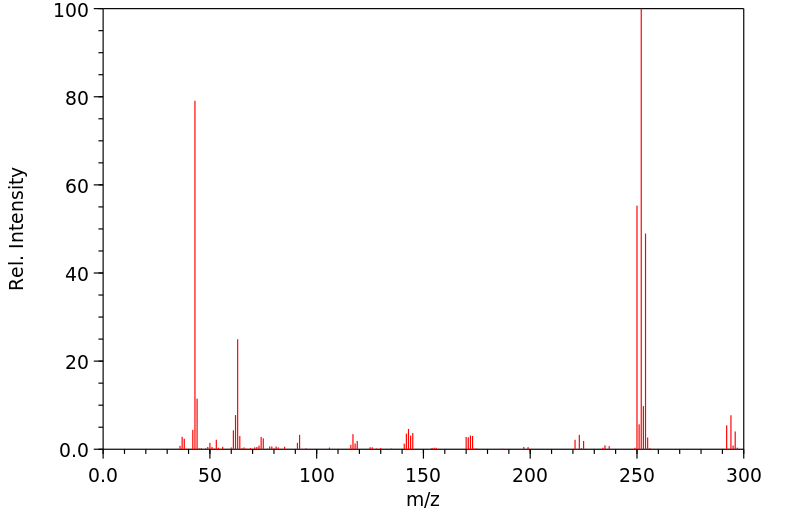2,4-二溴苯酚乙酸酯 | 36914-79-1
中文名称
2,4-二溴苯酚乙酸酯
中文别名
——
英文名称
2,4-dibromophenyl acetate
英文别名
(2,4-dibromophenyl) acetate
CAS
36914-79-1
化学式
C8H6Br2O2
mdl
——
分子量
293.942
InChiKey
RXBCSBQMWRLETO-UHFFFAOYSA-N
BEILSTEIN
——
EINECS
——
-
物化性质
-
计算性质
-
ADMET
-
安全信息
-
SDS
-
制备方法与用途
-
上下游信息
-
文献信息
-
表征谱图
-
同类化合物
-
相关功能分类
-
相关结构分类
物化性质
-
熔点:33.1-33.4 °C
-
沸点:303.7±32.0 °C(Predicted)
-
密度:1.843±0.06 g/cm3(Predicted)
-
溶解度:可溶于氯仿(少许)、甲醇(少许)
计算性质
-
辛醇/水分配系数(LogP):2.9
-
重原子数:12
-
可旋转键数:2
-
环数:1.0
-
sp3杂化的碳原子比例:0.12
-
拓扑面积:26.3
-
氢给体数:0
-
氢受体数:2
SDS
上下游信息
反应信息
-
作为反应物:描述:2,4-二溴苯酚乙酸酯 在 氢氧化钾 、 三氯化铝 作用下, 以 乙醇 为溶剂, 反应 4.0h, 生成 (E)-1-(3,5-Dibromo-2-hydroxy-phenyl)-3-pyridin-3-yl-propenone参考文献:名称:Thakar; Joshi, Journal of the Indian Chemical Society, 1982, vol. 59, # 1, p. 77 - 79摘要:DOI:
-
作为产物:描述:参考文献:名称:氯化锂存在下镁的制备多官能芳基镁,芳基锌和苄基锌试剂摘要:LiCl的存在极大地促进了镁向各种芳族和杂环溴化物中的插入。几个功能组,如-OBoc,-OTs,-Cl,-F,-CF 3,-OMe,-NMe 2和-N 2 NR 2,具有很好的耐受性。氰基的存在在某些情况下导致有机卤化物竞争性还原为相应的ArH化合物。通过ZnCl 2原位捕获中间镁试剂可以耐受甲基或乙基酯等敏感基团的存在。该方法也可用于由苄基氯化物制备官能化的苄基锌试剂。如果是二溴或三溴芳基衍生物,则应使用诸如-OPiv,-OTs,-N之类的指导基团2 NR 2或-OAc将锌插入(Zn / LiCl)定向到邻位,而与Mg / LiCl或Mg / LiCl / ZnCl 2的反应导致区域选择性插入对碳-溴键中。描述了所有金属化步骤的大规模实验(20–100 mmol)。DOI:10.1002/chem.200900575
文献信息
-
Polymer-supported gadolinium triflate as a convenient and efficient Lewis acid catalyst for acetylation of alcohols and phenols作者:Hyo-Jin Yoon、Sang-Myung Lee、Jong-Ho Kim、Hong-Jun Cho、Jung-Woo Choi、Sang-Hyeup Lee、Yoon-Sik LeeDOI:10.1016/j.tetlet.2008.03.005日期:2008.5(CMPS-IM-Gd) catalyst was prepared from chloromethyl polystyrene (CMPS) resin using a simple and convenient procedure. This polymeric catalyst was used as an efficient Lewis acid catalyst for the acetylation of various alcohols and phenols with acetic anhydride, affording high yields under mild conditions. The reaction was completed in a short period of time with small amounts of the catalyst. The catalyst
-
Ligand-Promoted Palladium-Catalyzed C−H Acetoxylation of Simple Arenes作者:Carolina Valderas、Kananat Naksomboon、M. Ángeles Fernández-IbáñezDOI:10.1002/cctc.201600757日期:2016.10.20The palladium‐catalyzed C−H oxidation of simple arenes is an attractive strategy to obtain phenols, which have many applications in the fine chemicals industry. Although some advances have been made in this research area, low reactivity and selectivity are, in general, observed. This report describes a new catalytic system for the efficient C−H acetoxylation of simple arenes based on Pd(OAc)2 and a
-
The synthesis and transition temperatures of ester derivatives of 2-fluoro-4-hydroxy- and 3-fluoro-4-hydroxybenzonitriles also incorporating aliphatic ring systems作者:Stephen M. Kelly、Hanspeter SchadDOI:10.1002/hlca.19840670624日期:1984.9.26The synthesis and liquid-crystal transition temperatures of forty ester derivatives of 2-fluoro-4-hydroxybenzonitrile and 3-fluoro-4-hydroxybenzonitrile are reported. The esters contain the trans-1,4-disubstituted cyclohexane or the 1,4-disubstituted bicyclo[2.2.2]octane rings (some contain an additional phenyl ring). Many of the novel F-substituted esters exhibit substantially higher nematic-isotropic
-
Directed Ortho Insertion (DoI): A New Approach to Functionalized Aryl and Heteroaryl Zinc Reagents作者:Nadège Boudet、Shohei Sase、Pradipta Sinha、Ching-Yuan Liu、Arkady Krasovskiy、Paul KnochelDOI:10.1021/ja074060h日期:2007.10.1A wide range of directing groups (ester, ketone, acetate, aryl sulfonate, triazene, carbamate) allow the regioselective directed ortho insertion (DoI) of zinc in the presence of LiCl leading to polyfunctional aryl and heteroaryl zinc reagents.
-
Insecticides申请人:IMPERIAL CHEMICAL INDUSTRIES PLC公开号:EP0260832A2公开(公告)日:1988-03-23A method of killing or controlling insect, mite or nematode pests which method comprises applying to the pest or to the locus thereof an effective amount of a compound of formula (I): wherein R is hydrogen or C1-4 alkyl; and X, Y and Z are independently selected from hydrogen, halogen, or OR¹ where R¹ is optionally substituted aryl or heteroaryl group. Certain of the compounds of formula (I) are novel and these form a further aspect of the invention一种杀灭或控制昆虫、螨虫或线虫害虫的方法,该方法包括向害虫或害虫所在地施用有效量的式(I)化合物: 其中 R 是氢或 C1-4 烷基;X、Y 和 Z 独立选自氢、卤素或 OR¹,其中 R¹ 是任选取代的芳基或杂芳基。 某些式(I)化合物是新颖的,它们构成了本发明的另一个方面
表征谱图
-
氢谱1HNMR
-
质谱MS
-
碳谱13CNMR
-
红外IR
-
拉曼Raman
-
峰位数据
-
峰位匹配
-
表征信息
同类化合物
马来酰亚胺四聚乙二醇CH2CH2COOPFPESTER
马来酰亚胺六聚乙二醇CH2CH2COOPFPESTER
马来酰亚胺-酰胺-PEG8-四氟苯酚酯
马来酰亚胺-四聚乙二醇-五氟苯酯
马来酰亚胺-三聚乙二醇-五氟苯酚酯
靛酚乙酸酯
阿立哌唑标准品002
间硝基苯基戊酸酯
间氯苯乙酸乙酯
间乙酰苯甲酸
钾4-乙酰氧基苯磺酸酯
酚醛乙酸酯
邻苯二酚二乙酸酯
邻甲苯基环己甲酸酯
邻甲氧基苯乙酸酯
辛酸苯酯
辛酸对甲苯酚酯
辛酸五氯苯基酯
辛酸-(3-氯-苯基酯)
辛酰溴苯腈
苯酰胺,3,4-二(乙酰氧基)-N-[6-氨基-1,2,3,4-四氢-1-(4-甲氧苯基)-3-甲基-2,4-二羰基-5-嘧啶基]-
苯酚-乳酸
苯酚,4-异氰基-,乙酸酯(ester)
苯酚,4-[(四氢-2H-吡喃-2-基)氧代]-,乙酸酯
苯酚,3-(1,1-二甲基乙基)-,乙酸酯
苯酚,2-溴-3-(二溴甲基)-5-甲氧基-,乙酸酯
苯甲醇,4-(乙酰氧基)-3,5-二甲氧基-
苯甲酸,4-(乙酰氧基)-2-氟-
苯氧基氯乙酸苯酯
苯基金刚烷-1-羧酸酯
苯基氰基甲酸酯
苯基庚酸酯
苯基庚-6-炔酸酯
苯基己酸酯
苯基呋喃-2-羧酸酯
苯基吡啶-2-羧酸酯
苯基十一碳-10-烯酸酯
苯基乙醛酸酯
苯基乙酸酯-d5
苯基丙二酸单苯酯
苯基丙-2-炔酸酯
苯基丁-2,3-二烯酸酯
苯基4-乙基环己烷羧酸
苯基3-乙氧基-3-亚氨基丙酸盐
苯基2-(苯磺酰基)乙酸酯
苯基2-(4-甲氧基苯基)乙酸酯
苯基2-(2-甲氧基苯基)乙酸酯
苯基2-(2-甲基苯基)乙酸酯
苯基-乙酸-(2-甲酰基-苯基酯)
苯基-乙酸-(2-环己基-苯基酯)







